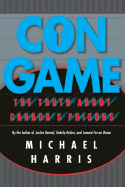Con Game: The Truth About Canada's Prisons

by Michael Harris
ISBN: 0771039611
Post Your Opinion | | A Review of: Con Game: The Truth about Canada∆s Prisons
by David ColterjohnWhen John Howard was appointed High Sheriff of Bedfordshire in 1773,
no one expected him to take his job too seriously. The appointment
was meant as a political sinecure, but since the title included
responsibility for the Bedford jail, Howard decided that he ought
to inspect the premises. He was so appalled at what he saw that he
traveled all over the country on a hopeless quest, seeking a better
example for the local jailer to follow. The result was a landmark
book, The State of Prisons in England and Wales. First published
in 1777, the book launched a movement for prison reform that has
continued up to the present day.
In Con Game, The Truth about Canada's Prisons, award-winning author
Michael Harris argues that all this damn progress has gone too far.
In the last 20 or 30 years, a series of well-intentioned but
ultimately naive laws and court decisions have worked together with
philosophically misguided internal policies to create a monster.
According to Harris, the Correctional Service of Canada and its
junior partner the National Parole Board (NPB) have morphed into a
secretive, anti-democratic bureaucracy that is indirectly responsible
for the murders of hundreds of innocent Canadians.
Most people are at least dimly aware of the fact that very few
Canadian offenders serve out their full sentences, but they probably
don't know how very little time some of them spend behind bars.
According to Harris, the average inmate gets full parole after
serving only 39.8 percent of their sentence. Under the new Accelerated
Parole Review, non-violent, first time offenders are released after
serving a mere one-sixth of their sentences. Unless they have been
classified as "dangerous offenders" or are serving a life
sentence, even the most recalcitrant inmates are released when they
reach their "statutory release" date, which means they
have been incarcerated for only two-thirds of their actual sentence.
Turned out unreformed on society, as many as 43 percent of federal
prisoners reoffend.
In order to explain this failure, Harris takes his readers on an
inside tour of Canada's penal system. What emerges is a series of
prison portraits that range from comically cushy to downright deadly.
While some inmates have their own room keys and work out on
state-of-the-art exercise equipment, others (51 in ten years) are
murdered in cold blood. Despite the Correctional Service's
"zero-tolerance" policy, drug and alcohol abuse have
reached epidemic proportions and convicted drug traffickers conduct
their business inside with impunity.
As Harris describes it, the average prison guards' job is an
unmitigated nightmare. Guards work short-staffed and mostly unarmed.
They are verbally abused on a daily basis and routinely showered
with urine and feces. Interacting with some of Canada's most unsavory
citizens, correctional officers have to deal with fires, riots, and
escapes with one eye constantly turned to a set of labyrinthine
regulations all designed to protect the prisoners' rights.
Perhaps the most shocking example occurs midway through the book,
when Harris describes an incident when an inmate repeatedly raped
a Kingston Penitentiary office worker. The Emergency Response Team
stood outside the office for hours, helplessly watching the assaults
while they waited for negotiations with the "inmates committee"
to be resolved. A multitude of similar examples lead Harris to
conclude that it is the inmates, not the staff, who are really in
control of Canada's federal prisons.
Harris places much of the blame for this state of affairs on Ole
Ingstrup, a two-time Commissioner of the Correctional Service of
Canada, who retired from the service in 2000. In Harris's view,
Ingstrup, by blindly embracing an unworkable philosophy of
"restorative justice", has had an inordinate influence
over Canadian correctional policy. According to Harris, "It
is fashionable in federal government social policy circles to make
excuses for criminal behavior. Society, not the individual, is
somehow to blame for an offender's criminal acts. Touched by a
bureaucratic magic wand, perpetrators are transformed from criminals
into victims who are then entitled to non-judgmental support from
everyone, including their victims." He thinks this isn't just
getting things backwards-it's pushing the cart down a steep slope
without even bothering to attach the horse.
In Con Game, Harris breaks all the Politically Correct' rules. A
pugnacious and passionate writer, he shows us his cards up front
when he uses terms like "Canada's criminal class" or
describes someone he disagrees with as an "anti-capital
punishment ideologue." His analysis and recommendations are
designed to provoke controversy and will likely be used to anchor
debate by those on the political right.
But readers with more liberal leanings need not despair: There are
times when the author trips over his own anger and frustration.
Much of his argument appeals to one of the worst features of human
nature-the innate self-righteousness that those who obey the law
feel towards those who do not.
Harris may loathe the construct of the criminal as "victim of
society," but he provides his ideological opponents with a
number of passages that actually support this thesis. For example,
he notes that most of Canada's felons come from dysfunctional,
abusive families, are undereducated, have unstable employment
histories and engage in serious substance abuse. Multiply these
problems sevenfold and you get a pretty accurate picture of the
incarceration rates among Canada's aboriginal peoples. Surely society
needs to assume a little responsibility here too.
On top of this, Harris relies far too heavily on prison guards'
testimony, spending far too little of his ink on actual prison
inmates. Besides, even if 43 percent of Canadian offenders end up
back in jail, it must be obvious that 57 percent of them do not.
In a book that spans over 350 pages of highly charged polemical
argument, Harris might have devoted at least a chapter or two to
those offenders for whom the "restorative" model seems
to have worked.
|